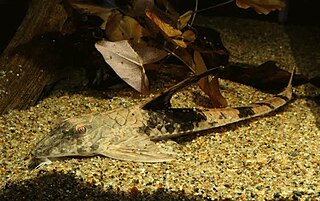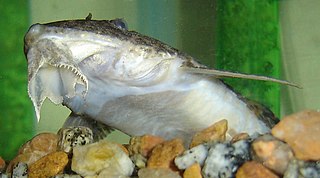
Rineloricaria is a genus of freshwater tropical catfish belonging to the family Loricariidae. They are commonly called whiptail catfish because of the long filament that grows out of the tip of the caudal fin that is characteristic of the genus. With the exception of R. altipinnis from Panama, they are native to the rivers of northern and central South America. Some species are regularly seen in the aquarium trade.
Loricaria parnahybae is a species of catfish in the family Loricariidae. It is native to South America, where it occurs in coastal rivers of Brazil and French Guiana. It is typically found in environments characterized by a sandy substrate. The species reaches 16 cm in standard length and is believed to be a facultative air-breather.

Loricaria simillima is a species of catfish in the family Loricariidae. It is native to South America, where it occurs in the basins of the Amazon River, the Orinoco, and the Río de la Plata in Argentina, Brazil, Ecuador, Paraguay, Peru, and Venezuela. The species reaches 26.4 cm in standard length and is believed to be a facultative air-breather.
Rineloricaria stewarti, sometimes known as Stewart's whiptail catfish, is a species of catfish in the family Loricariidae. It is native to South America, where it occurs in the coastal rivers of the Guianas, being known from French Guiana, Guyana, and Suriname. It is typically seen in moderately sunlit forest creeks with a depth of 10 to 60 cm, clear, fast-moving water, and a substrate composed of rocks and sand. It is known to occur alongside the species Corydoras guianensis and Moenkhausia oligolepis, as well as members of the genus Phenacogaster.
Rineloricaria beni is a species of catfish in the family Loricariidae. It is native to South America, where it occurs in the Beni River basin, from which its specific name is derived, in Bolivia. The species reaches 7.8 cm in standard length and is believed to be a facultative air-breather.
Rineloricaria cadeae, sometimes known as the Cadéa whiptail catfish, is a species of catfish in the family Loricariidae. It is native to South America, where it is known from Brazil and Uruguay, including the Lagoa dos Patos drainage basin and the Cadeia River, for which it is named. It is typically found in areas with flowing water of variable speed and turbidity, with a variety of substrates also being reported as habitat for the species. Adult individuals of the species are frequently found in sandy areas, whereas juveniles are believed to prefer the leaves of marginal vegetation. The species reaches 12.8 cm in standard length and is believed to be a facultative air-breather.
Rineloricaria fallax, sometimes known as the whiptail loricaria, is a species of catfish in the family Loricariidae. It is native to South America, where it occurs in the upper Rupununi and Branco River basins in Brazil and Guyana. Although the species has been reported from Paraguay, this has been determined to be a misidentification. The species reaches 15.7 cm in standard length and is believed to be a facultative air-breather. It is known to spawn in caves, with males tending the clutch and assisting the fry in emerging from the eggs.
Rineloricaria hoehnei is a species of catfish in the family Loricariidae. It is native to South America, where it occurs in the Paraguay River basin in Brazil. The species reaches 5.8 cm in standard length and is believed to be a facultative air-breather. In 2011, Rineloricaria hoehnei was found to be a probable junior synonym of Rineloricaria lanceolata, although FishBase recognizes both as distinct and valid species.
Rineloricaria kronei is a species of catfish in the family Loricariidae. It is native to South America, where it occurs in the Ribeira de Iguape River basin in Brazil. The species is believed to be a facultative air-breather.
Rineloricaria lima is a species of catfish in the family Loricariidae. It is native to South America, where it is known from Argentina, Brazil, and Uruguay. The species is believed to be a facultative air-breather.
Rineloricaria parva is a species of catfish in the family Loricariidae. It is native to South America, where it occurs in the Paraguay River basin in Argentina, Brazil, and Paraguay. The species reaches 11 cm in standard length and is believed to be a facultative air-breather.
Rineloricaria wolfei is a species of catfish in the family Loricariidae. It is native to South America, where it occurs in the Ucayali River basin in Peru. The species reaches 14.9 cm in length and is believed to be a facultative air-breather.

Rineloricaria longicauda, commonly known as the elongated whiptail catfish, is a species of catfish in the family Loricariidae. It is native to South America, where it occurs in coastal drainage basins between Chuí and Tramandaí in the state of Rio Grande do Sul in Brazil, although it has also been reported from Uruguay. In environments with clear to brown water, slow to moderate water flow, and substrates made of sand or mud, it is frequently found. The species reaches 13.2 cm in standard length and is believed to be a facultative air-breather.
Rineloricaria cacerensis is a species of catfish in the family Loricariidae. It is native to South America, where it occurs in the Paraguay River basin in Brazil, with its type locality reportedly being Cáceres in the state of Mato Grosso. The species is believed to be a facultative air-breather, like other members of the genus Rineloricaria.

Rineloricaria eigenmanni is a species of catfish in the family Loricariidae. It is native to South America, where it is known from Venezuela, with its type locality being listed as near Sarare and is also found in and the Orinoco River in Venezuela and Colombia. The species reaches 10.2 cm in standard length and is believed to be a facultative air-breather.
Rineloricaria hasemani is a species of catfish in the family Loricariidae. It is native to South America, where it occurs in the lower Amazon River drainage basin, including the basin of Tocantins River, in Brazil. The species reaches 19.8 cm in standard length and is believed to be a facultative air-breather.
Rineloricaria melini is a species of catfish in the family Loricariidae. It is native to South America, where it occurs in the Amazon River basin in Brazil. The species reaches 13 cm in standard length and the maximum length can reaches 18-20 cm and is believed to be a facultative air-breather.
Rineloricaria platyura is a species of catfish in the family Loricariidae. It is native to South America, where it occurs in coastal rivers from the mouth of the Amazon River to the Essequibo River in French Guiana, Guyana, and Brazil. The species reaches 14 cm in standard length and is believed to be a facultative air-breather.
Rineloricaria strigilata, commonly known as the Santa Cruz whiptail catfish, is a species of catfish in the family Loricariidae. It is native to South America, where it is known from southern Brazil and Uruguay, with its type locality being listed as the Lagoa dos Patos basin near Santa Cruz do Sul. It is typically found in environments with slow to fast water flow, clear to brown water, and a substrate composed of sand or mud. The species reaches 13.9 cm in standard length and is believed to be a facultative air-breather.



